
Water released into storm drains is a significant concern in Oklahoma City. Freshwater fish and other aquatic life in Oklahoma lakes are unable to survive the chlorine, contaminants, and chemicals that are illegally poured into storm drains.
The drains along the curbs of roads, in parking lots, or other built-up areas are called storm drains and usually lead to surface water, not sanitary sewer systems. Stormwater drains are designed to prevent flooding by channeling rainwater from roads, parking lots, construction sites, and urban areas back into lakes, streams, ponds, and rivers quickly.
Most storm drains are not connected to any treatment facilities – what goes down the drain leads straight to a body of surface water. Applying excessive lawn fertilizer or weed killer increases the risk of runoff after rainfall.
Paint or paint-cleaning water should not be poured into storm drains. It can pollute and harm local waterways. Unlike sink drains, storm drains lead directly to rivers and streams without any treatment, so anything poured in there can contaminate the environment directly.
A gallon of used oil from a vehicle oil change, poured down a drain, can pollute up to one million gallons of freshwater. Small droplets of oil and antifreeze from the millions of cars on US roadways add to the stormwater pollutant load. Recycle used motor oil.
The Oklahoma Department of Environmental Quality collaborates with Oklahoma City to develop the Storm Water Management Plan (SWMP). The Storm Water Quality Division’s responsibilities include conducting inspections, enforcing rules, evaluating water quality, educating the public, managing household hazardous waste services, and responding to emergencies for residents, businesses, and government organizations to maintain a clean and safe environment and ensure compliance with the Clean Water Act. All areas within Oklahoma City’s corporate limits serviced by permittee-owned or managed municipal separate storm sewers are included in the SWMP.
The Canadian River (216.1 sq. miles), Deer Creek (102.3 sq. miles), the Deep Fork River basin (105.7 sq. miles), and the North Canadian (231.6 sq. miles) are the four major drainage basins that constitute Oklahoma City. Discharging swimming pool water into storm drains is a significant issue.
Draining chlorinated pool water into storm drains contravenes the law. Without filtration, the water from these sewers flows directly into nearby streams and reservoirs.
Before discharging pool water into a storm drain, de-chlorinate it if your pool is not connected to a conventional sanitary sewer. According to the Oklahoma City Municipal Code, fines for each infringement can range from $200 to $1,000 per full day.
Trending Now
Hot
Latest Trending
Waterway Clean Sweep Program
By participating in the Waterway Clean Sweep Program as a volunteer, communities, businesses, and people alike have the opportunity to make a substantial contribution to their own communities. Interested parties can apply to organize their own clean-up date or join...
M20 Sweeper-Scrubber cleaning machine
The Capitol Cleaning crew is more efficient without the need for multiple machines. This state of the art integrated cleaning machine has technology that combines exceptional sweeping and scrubbing performance. Able to clean outdoors and indoors, this versatile M20...
OKC drinking water is safe to consume
The water system in Oklahoma City began in 1889, when the city was merely a thriving prairie encampment. Over a century later, Oklahoma City's supply is going to endure because of the unwavering dedication of visionary leaders who recognized the need to increase our...
